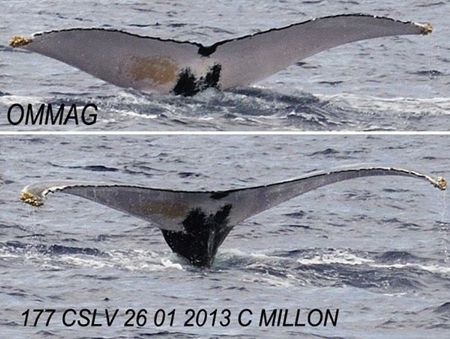 Photo-identification (or photo ID) is a non-invasive technique used by scientists around the world to study whale and dolphin populations, associations and migrations. Like human finger prints, each animal within a population is unique and has distinctive, often identifiable markings which distinguish it from other individuals. Nicks or marks on the body surface are photographed and provide a permanent record of the individual. The part of the animal used for photo ID varies between species but is most commonly the dorsal fin or tail fluke. Through international cooperation, by researchers in different locations, by matching photographs of the same individual at different times and in different locations it is possible to learn more about the movements and life histories of that individual and its associates.
Photo-identification (or photo ID) is a non-invasive technique used by scientists around the world to study whale and dolphin populations, associations and migrations. Like human finger prints, each animal within a population is unique and has distinctive, often identifiable markings which distinguish it from other individuals. Nicks or marks on the body surface are photographed and provide a permanent record of the individual. The part of the animal used for photo ID varies between species but is most commonly the dorsal fin or tail fluke. Through international cooperation, by researchers in different locations, by matching photographs of the same individual at different times and in different locations it is possible to learn more about the movements and life histories of that individual and its associates.
The Song of the Whale team collect photo-id images of various species to contribute to international catalogues of the flukes and dorsal fins of whales whenever possible. These images are then submitted to various international photo id catalogues, including NAMSC (for sperm whales in the N Atlantic and Mediterranean, and the North Atlantic Humpback Whale catalogue). Every so often, a photographic match between two photographs is found; this is very exciting, especially when the match is from an entirely different part of the world and many years later.
Recently, a humpback whale photographed by the SOTW team off Iceland in 2006 was matched for the first time with a photograph taken off Guadeloupe (French West Indies) in 2013.
The North Atlantic Humpback Whale Catalogue curated by Allied Whale at the College of the Atlantic in the USA, matched these photos. It now has records of over 8,000 individual humpback whales identified over more than four decades from all of the known concentrations of humpback whales across the ocean basin. It is a hugely collaborative project, with more than 600 scientists, photographers and interested individuals contributing. This photo-identification research has revealed that humpbacks migrate to warm waters (for example, in the Caribbean) to mate and calve, and travel to colder northern waters in the summer to feed, and that humpbacks reach sexual maturity at 4 or 5 years of age and calve every two years.
Sorry, comments are closed for this post.